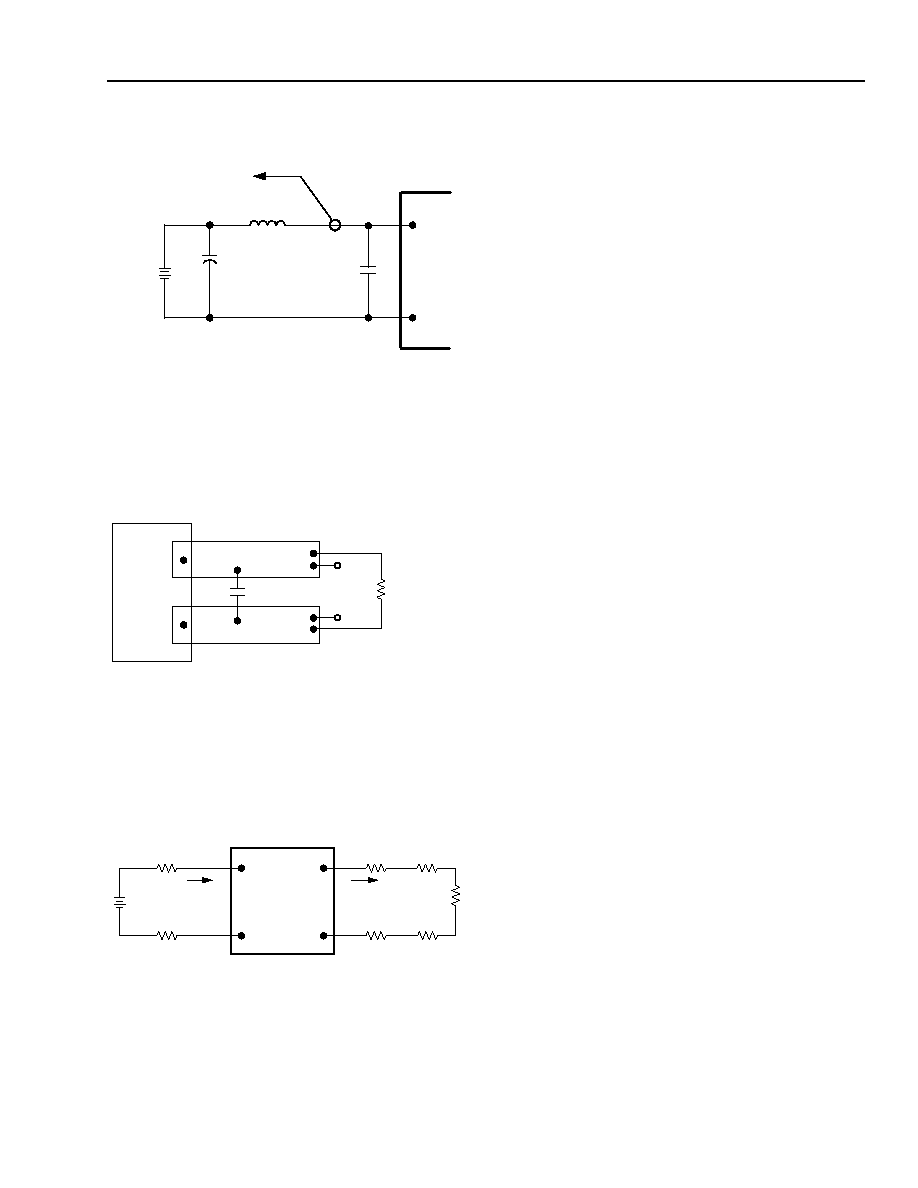- 您現(xiàn)在的位置:買(mǎi)賣(mài)IC網(wǎng) > PDF目錄43902 > LC020C (LINEAGE POWER LLC) DC-DC REG PWR SUPPLY MODULE PDF資料下載
參數(shù)資料
| 型號(hào): | LC020C |
| 廠商: | LINEAGE POWER LLC |
| 元件分類(lèi): | 電源模塊 |
| 英文描述: | DC-DC REG PWR SUPPLY MODULE |
| 文件頁(yè)數(shù): | 16/16頁(yè) |
| 文件大?。?/td> | 437K |
| 代理商: | LC020C |
第1頁(yè)第2頁(yè)第3頁(yè)第4頁(yè)第5頁(yè)第6頁(yè)第7頁(yè)第8頁(yè)第9頁(yè)第10頁(yè)第11頁(yè)第12頁(yè)第13頁(yè)第14頁(yè)第15頁(yè)當(dāng)前第16頁(yè)

Lineage Power
9
Data Sheet
April 2008
18 Vdc to 36 Vdc Inputs; 20 W
LC020 Single-Output Series Power Module:
Test Configurations
8-203
Note: Input reflected-ripple current is measured with a simulated
source impedance of 12 H. Capacitor Cs offsets possible
battery impedance. Current is measured at the input of the
module.
Figure 16.Input Reflected-Ripple Test Setup
8-513
Note: Use a 0.1 F ceramic capacitor. Scope measurement should
be made using a BNC socket. Position the load between
50 mm (2 in.) and 75 mm (3 in.) from the module.
Figure 17.Peak-to-Peak Output Noise
Measurement Test Setup
8-204
Note: All measurements are taken at the module terminals. When
socketing, place Kelvin connections at module terminals to
avoid measurement errors due to socket contact resistance.
Figure 18.Output Voltage and Efficiency
Measurement Test Setup
Design Considerations
Grounding Considerations
For standard units, the case is connected internally to
VI(–). For units with the case ground pin option, the
case is not connected internally allowing the user flexi-
bility in grounding.
Input Source Impedance
The power module should be connected to a low ac-
impedance input source. Highly inductive source
impedances can affect the stability of the power mod-
ule. For the test configuration in Figure 16, a 33 F
electrolytic capacitor (ESR < 0.7 at 100 kHz)
mounted close to the power module helps ensure sta-
bility of the unit. For other highly inductive source
impedances, consult the factory for further application
guidelines.
Safety Considerations
For safety-agency approval of the system in which the
power module is used, the power module must be
installed in compliance with the spacing and separation
requirements of the end-use safety agency standard,
i.e., UL-60950, CSA 22.2-950 No. 60950-00, and VDE
0805 (IEC60950).
For the converter output to be considered meeting the
requirements of safety extra low voltage (SELV), the
input must meet SELV requirements.
If the input meets extra low voltage (ELV) require-
ments, then the converter’s output is considered ELV.
The input to these units are to be provided with a maxi-
mum 5 A normal-blow fuse in the ungrounded lead.
Feature Descriptions
Overcurrent Protection
To provide protection in a fault (output overload) condi-
tion, the unit is equipped with internal current-limiting
circuitry and can endure current limiting for an unlim-
ited duration. At the point of current-limit inception, the
unit shifts from voltage control to current control. If the
output voltage is pulled very low during a severe fault,
the current-limit circuit can exhibit either foldback or tai-
lout characteristics (output-current decrease or
increase). The unit operates normally once the output
current is brought back into its specified range.
TO OSCILLOSCOPE
12 H
CS 220 F
IMPEDANCE < 0.1
Ω
@ 20 C, 100 kHz
VI(+)
VI(-)
BATTERY
33 F
LTEST
V O (+)
V O (-)
0.1 F
RESISTIVE
LOAD
SCOPE
COPPER STRIP
VI(+)
VI(-)
VO(+)
VO(-)
II
IO
SUPPLY
CONTACT RESISTANCE
CONTACT AND
DISTRIBUTION LOSSES
LOAD
η
VO(+) VO(–)
–
[]IO
VI(+) VI(–)
–
[]II
------------------------------------------------
100
×
=
相關(guān)PDF資料 |
PDF描述 |
|---|---|
| LC410591FN | SWITCHED CAPACITOR CONVERTER, 600 kHz SWITCHING FREQ-MAX, QCC16 |
| LC5523FLF3054 | POWER FACTOR CONTROLLER, 18 kHz SWITCHING FREQ-MAX, ZFM7 |
| LC5523FLF3051 | POWER FACTOR CONTROLLER, 18 kHz SWITCHING FREQ-MAX, ZFM7 |
| LC7153M | PLL FREQUENCY SYNTHESIZER, 160 MHz, PDSO24 |
| LC72121M | PLL FREQUENCY SYNTHESIZER, 160 MHz, PDSO24 |
相關(guān)代理商/技術(shù)參數(shù) |
參數(shù)描述 |
|---|---|
| LC-020C-8-SS | 制造商:MISC SPRINGS 功能描述: |
| LC020CD-12S | 制造商:MISC SPRINGS 功能描述: |
| LC02-1003G | 制造商:SEI Stackpole Electronics Inc 功能描述: |
| LC02204 | 制造商:C&K Components 功能描述:- Bulk |
| LC02-2201G | 制造商:SEI Stackpole Electronics Inc 功能描述: |
發(fā)布緊急采購(gòu),3分鐘左右您將得到回復(fù)。